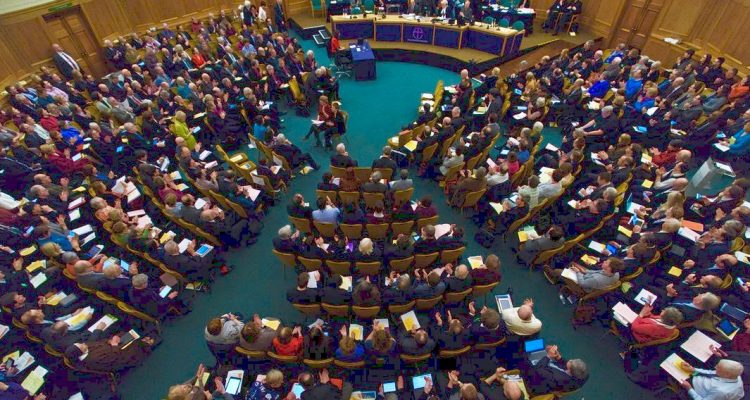
The afternoon session of General Synod on Feb. 14 was fairly sleepy, save for swift moves at the beginning and an announcement on the sexuality debate at the end.
Initially, a series of motions passed in quick succession, some of significant consequence, but they had been debated in previous meetings of General Synod. For example, GS 2027A is intended to clear up certain kinds of “burdensome” ecclesiastical legislation without bringing proposed changes before Synod multiple times, as the current process of legislation “by Measure” requires. Various members of Synod expressed concern about this legislation in the past, due to potential abuses, but many now testified that the revision committee had allayed their fears.
Synod brief debated GS 2046, a “simplification package” of various changes related to Parochial Church Councils, the regulation of local ecumenical cooperation, and ordination, but the legislation was only coming up for a first hearing and is destined for further revision in committee. While considering changes to the ecumenical canons, many Synod Members confessed they had been unaware of the rules and that they were afraid their parish had probably broken many of them without knowing it.
GS 2048 relates to clergy retirement and the possibility of allowing ministers older than 70 to continue in their service, so long as they obtain the agreement of their bishop. As the Archbishop of Canterbury later said, the legislation is intended “to clear up anomalies where different laws apply to different people,” and was not intended to shore up clergy numbers.
The Rev. Damian Feeney (Lichfield) spoke in favor of the motion, saying “there are clergy of a certain age who are actually in their prime at the time we are talking about.”
He then read email from a friend who is of retirement age: “I confirm that my wardens have been told that I have to go this year as I become 72, even though we are a growing church with a respected place within the community,” and no replacement is in line. Feeney’s friend is a house-for-duty priest in a small village who still works full time.
Others also spoke in favor, although there were hesitations regarding the language used to describe the retirement of priests, concerns about whether the church could fall afoul of broader national legislation meant to address ageism, and worries that an increase in older priests could harm the church’s mission.
“The role models we put in front of people are simply getting older and older,” said the Rev. Miranda Threlfall-Holmes (Durham). She said some studies show that clergy tend to attract people to their parishes who are about their own age: “ten years on either side.” Could the church miss out on its mission to the young?
Possible amendments to the motion, on the retirement of archbishops and to the role of Parochial Church Councils, failed. The motion passed.
A brief debate arose on changes to canons regulating clergy vesture (see GS 2029A and 2029AA), but it occurred so close to the end of the evening that it could not be completed. Proposed changes would allow greater flexibility to individual priests in determining the proper sort of vesture suitable to their context. If there is time remaining in other legislative sessions, debate will resume.
The archbishops conferred and agreed to propose changes to the schedule for Feb. 15. Further time is being allowed for group work and for debate on the bishops’ report on marriage during the day’s sessions.









